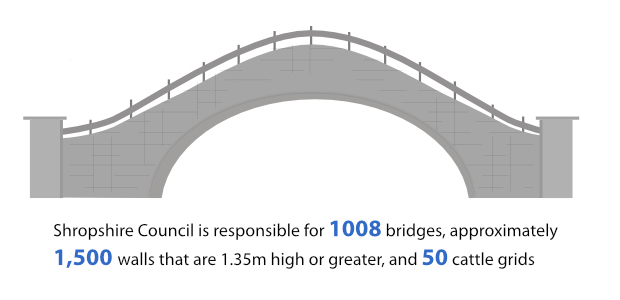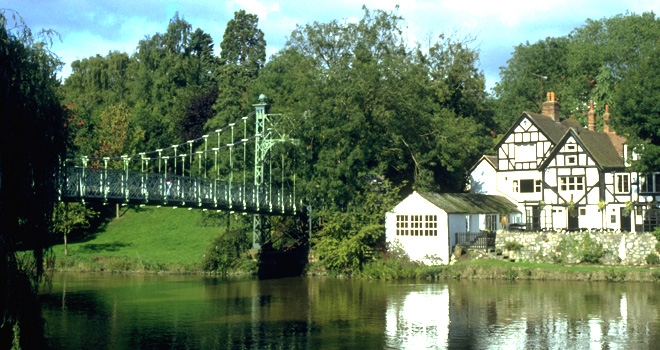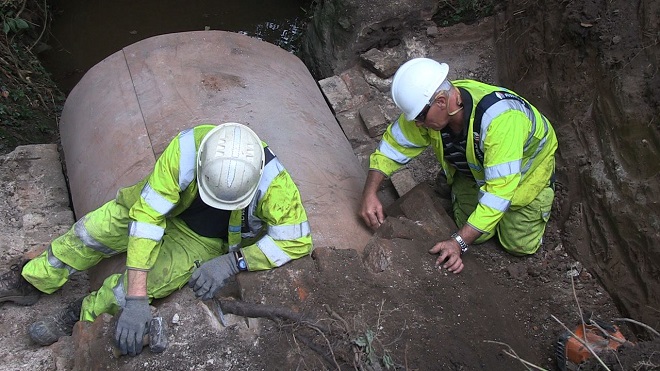Bridge maintenance
We're responsible for a wide range of structures. In this blog, and in the video below, we look at the work we carry out to inspect and maintain Shropshire’s bridges, walls and cattle grids.
Video: Bridge inspections and maintenance
What bridges and structures are we responsible for?
We're responsible for around 1008 bridges, approximately 1,500 walls that are 1.35m high or greater, and around 50 cattle grids.
The 1008 bridges/culverts consist of around 832 with a span of 1.5m or more, and around 176 with a span between 0.9m and 1.49m.

We’re responsible for the majority of road and footbridges in the county, but there are a significant number of bridges that are owned and maintained by other organisations, such as Network Rail and the Canals and Rivers Trust (formerly British Waterways Board).
We maintain records of these and if we receive any enquiries we’ll pass them on to the appropriate owner or organisation.

Image: Porthill Suspension Bridge, Shrewsbury, which was repaired and refurbished in 2012
How do we decide which bridges need inspecting and maintenance work?
With more than 1,000 bridges in the Shropshire Council area it takes a lot of advance planning, time, effort and money to ensure that these bridges are regularly inspected and, where needed, repaired/maintained.
This work is essential to ensure that our bridges remain in good condition but, more importantly, that they’re safe for use and fit for purpose for all road users.
Our aim is to ensure that our highway bridges and structures are safe by preventing problems before they happen – something which offers the best value for money. We prioritise workstreams by adopting a risk-based approach (RBA) to our annual inspection programmes, monitoring of weak/sub-standard structures and works programmes in accordance with the new Well-Managed Highway Infrastructure, Code of Practice (October 2016).
What work do we carry out?
We manage our bridges and structures through a programme of planned inspections and maintenance works.
Planned inspections
Every three years we carry out a ‘general inspection’ of our bridges.
Every six years we carry out a more detailed close visual inspection (known as a ‘principal inspection’) of our more complex and larger structures. There’s currently a list of around 90 bridges on the principal bridge inspection list.
In 2020/21, 323 bridges received a ‘general inspection’, and 15 received a detailed ‘principal inspection’.
Due to the configuration of some bridges and/or the obstacles that they cross (eg deep water or railway lines), it’s not always possible to fully inspect these bridges at a general inspection.
To enable a thorough inspection of those bridges, we use divers and or specialist access teams. Inspections of structures requiring a specialist confined or diver inspection team are generally carried out at six year intervals, unless severe flooding warrants an earlier ad-hoc emergency inspection.
Unplanned inspections
We also carry out 40-50 unplanned special inspections in a year to establish the condition of a bridge or other structure. These unplanned inspections are carried out following a report of a road traffic accident bridge strike or a concern raised by a member of the public.
Maintenance and urgent repairs
All works are scheduled into a programme of works for delivery in the current or future financial year, based on the findings of the annual bridge inspection programmes.
We prioritise and recommend urgent or high priority repair and maintenance works that are required on a risk-based approach and depending on the available annual budgets.
Bridge strengthening programme
During the late 1980s and the 1990s, we undertook a comprehensive assessment programme to determine the load carrying capacity of our bridges with a span of 1.5m or more. This was as a result of proposals to increase the weight of vehicles permitted to use the UK road network from 38 to 40 tonnes, in line with the EU.

Image: Maintenance work at Dudleston School West Bridge near Ellesmere
The assessment programme found that a number of bridges were unsuitable and, as a result, a bridge strengthening programme was instigated.
In addition to bridge strengthening schemes, major maintenance work is undertaken to replace or repair structures which fall outside the scope of the bridge assessment programme.
How is the work paid for?
The bridge strengthening programme and other major maintenance work are funded by central government.
Routine cyclical and minor maintenance works are funded from the council’s local revenue budget. The costs associated with accident damage are generally recovered from the driver’s insurance when driver details are available.
Budgets and work programmes are subject to change depending on emergency works arising throughout the year. The bridges team is currently working on a three year forward programme of works, which should be in place from April 2022.
What other structures do we maintain and how?
Retaining walls
Since 2006 we’ve identified around 1500 retaining walls associated with the highway network, although liability and ownership issues have yet to be formally determined.
Due to current funding constraints we can only undertake unplanned reactive works to retaining walls as and when the need arises.
Cattle grids
We’re responsible for 50 cattle grids and regularly carry out maintenance works, including the cleaning out of debris and the replacement of fencing and gates. In 2021/ 22 we've replaced two cattle grids that failed, namely Hints and Hill House Cattle Grids. We also plan to inspect all our cattle grids in early 2022 to ascertain their condition and prioritise any future maintenance works recommended.
Some recent examples of our work

Image: Ludford Bridge, Ludlow, after repair work was completed
In recent years we have successfully repaired and strengthened a number of bridges and structures across Shropshire. Click on the links below for some recent case studies...
- February 2017 - Perry Farm Bridge
- February 2017 - Jubilee Bridge
- November 2016 - Allum Bridge
- September 2016 - Dudleston School West Bridge
- May 2016 – Ludford Bridge, Ludlow (pictured)
- May 2016 – Eaton number 3 bridge